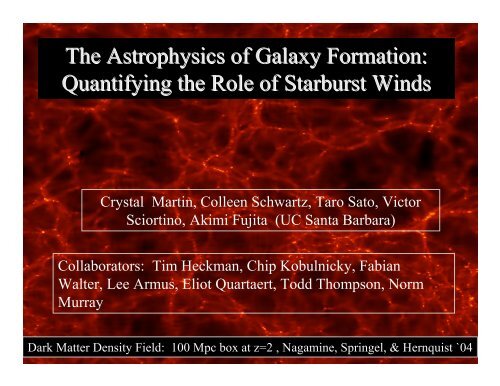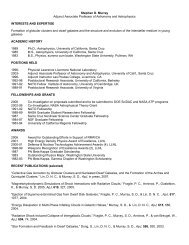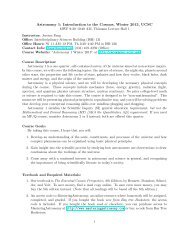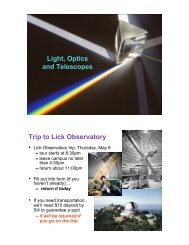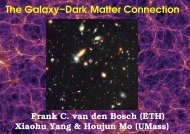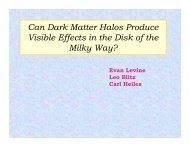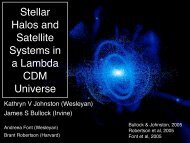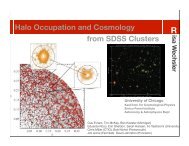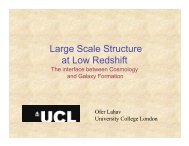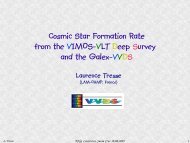Crystal Martin
Crystal Martin
Crystal Martin
You also want an ePaper? Increase the reach of your titles
YUMPU automatically turns print PDFs into web optimized ePapers that Google loves.
The Astrophysics of Galaxy Formation:<br />
Quantifying the Role of Starburst Winds<br />
<strong>Crystal</strong> <strong>Martin</strong>, Colleen Schwartz, Taro Sato, Victor<br />
Sciortino, Akimi Fujita (UC Santa Barbara)<br />
Collaborators: Tim Heckman, Chip Kobulnicky, Fabian<br />
Walter, Lee Armus, Eliot Quartaert, Todd Thompson, Norm<br />
Murray<br />
Dark Matter Density Field: 100 Mpc box at z=2 , Nagamine, Springel, & Hernquist `04
Hubble Ultra Deep Field<br />
Ω b = 0.04<br />
WHIM: 10 5 -10 7 K<br />
Cen & Ostriker 1999<br />
Ω *~ 0.1Ω b<br />
•Does Does Feedback Shape the<br />
Galaxy Luminosity Function?<br />
•How How Far do Winds Spread<br />
Heavy Elements?
Emission Line Observations Multiphase Winds<br />
Ott, <strong>Martin</strong>, &<br />
Walter 2003<br />
Suchkov 95,96<br />
<strong>Martin</strong>, Kobulnicky, &<br />
Heckman 2002<br />
Stevens et al. 2003<br />
Kobulnicky & <strong>Martin</strong> 2004
Metal-Enriched Winds<br />
<strong>Martin</strong>, Kobulnicky, & Heckman 2002<br />
Energy (keV)
Henize 2-10<br />
X-rays: Kobulnicky<br />
& <strong>Martin</strong> 2005<br />
UV: Schwartz &<br />
<strong>Martin</strong> 2005<br />
170 km/s
Absorption Lines Probe Outflows at all Epochs<br />
STIS Data: Schwartz et al. 2005<br />
Schwartz et al. 2005<br />
Shapley et al. 2003
Strickland<br />
Absorption Lines Are Sensitive to Diffuse Gas<br />
Keck ESI Spectra of Na I Doublet<br />
V = -435 km/s<br />
V = -96 km/s<br />
IRAS 17208-0014<br />
Doppler<br />
Shift =<br />
400 km/s Rest V<br />
IRAS 11506+1331
Slower Outflow Speeds in Dwarf Starburst Galaxies<br />
Schwartz & <strong>Martin</strong> 2004<br />
Keck HIRES Spectra near Na I Doublet<br />
34 km/s<br />
23 km/s<br />
SPEED<br />
LIMIT<br />
V MAX=1.7 C S<br />
650 km/s<br />
Why Don’t the Cool Clouds<br />
Reach the Speed of the Hot<br />
Wind?
Hot Gas Escapes from<br />
Dwarf Starbursts<br />
Rotation Speed <br />
C s = 380 km/s<br />
<strong>Martin</strong> 1999, Heckman et al 2000, <strong>Martin</strong> 2004<br />
Tremonti et al 2004<br />
<strong>Martin</strong> 2005
Na I Velocities<br />
AGN<br />
?<br />
V term = 650<br />
km/s<br />
<strong>Martin</strong> 2005
<strong>Martin</strong> 2004b
20<br />
kpc<br />
10<br />
kpc<br />
Na I Absorption Covers Large Angle<br />
….Suggests Wind Extends<br />
~20 kpc into Halo<br />
20<br />
kpc<br />
10<br />
kpc
M ~ 1.1e9 Msun
How Much Mass in<br />
Outflowing Cool Gas?<br />
IRAS1720-03: Can Supernovae Power the Outflow? YES<br />
Measure K.E. > 7e56 ergs<br />
SFR ==> E_SN (@10 Myr) ~ 30e56 ergs, or (@100 Myr) 1700e56 ergs
NaI Column Density vs Position along Slit<br />
M ~ 2.9e9 Msun<br />
M ~ 1.8e8 Msun<br />
M ~ 7.1e7 Msun<br />
320 Msun/yr<br />
450 Msun/yr<br />
250 Msun/yr
Halo/Wind Velocity Gradients
Angular Momentum Conservation?
Rotation+Orbit<br />
Summary of Halo<br />
Velocity Gradients<br />
1. Flat (Not-Rotatin)<br />
2. Break (Minor Axis?)<br />
3. Steep (Rotating?)<br />
Disk Rotation Orbital Motion
Merger-Driven Winds vs. vs.<br />
Starburst Winds<br />
• Shocks from Radial Encounters Generate Hot Gas Reservoir<br />
(Instead of SNe Shocks)<br />
• Large Variation in Energy/Mass with Impact Parameter<br />
(Instead of SFR)<br />
• Test with X-ray Observations and Shock-Like Emission-Line<br />
Diagnostics<br />
Cox et al 2004<br />
Continuous Starburst:<br />
e.g. IRAS1056+24<br />
10 Myr Ew = 3e57 ergs<br />
100 Myr Ew = 1.7e59<br />
ergs
Extended X-Ray Halos in ULIGS<br />
IRAS10565+2448 IRAS17208-0014<br />
Sciortino &<br />
<strong>Martin</strong> (2005)
Summary: Feedback in Different Mass Galaxies<br />
Reionization<br />
Hot Starburst Winds<br />
Galaxies<br />
Momentum-Driven<br />
Winds (SNe + Rad.)<br />
Number Density<br />
Luminosity<br />
AGN?<br />
Radio Galaxies?<br />
Halos<br />
Benson et al. 2003<br />
• Why Do Small Halos<br />
AND Large Halos Fail<br />
to Host Galaxies?<br />
1. Cooling Time<br />
2. Feedback<br />
a. SNe<br />
b. Merger Induced?
Toy Model #1:<br />
Angular Momentum Conservation<br />
i<br />
• Wind Launched from a ring at R0 with circular rotation speed V 0<br />
• Wind velocity is radial at angle theta_w<br />
• View at some inclination i


